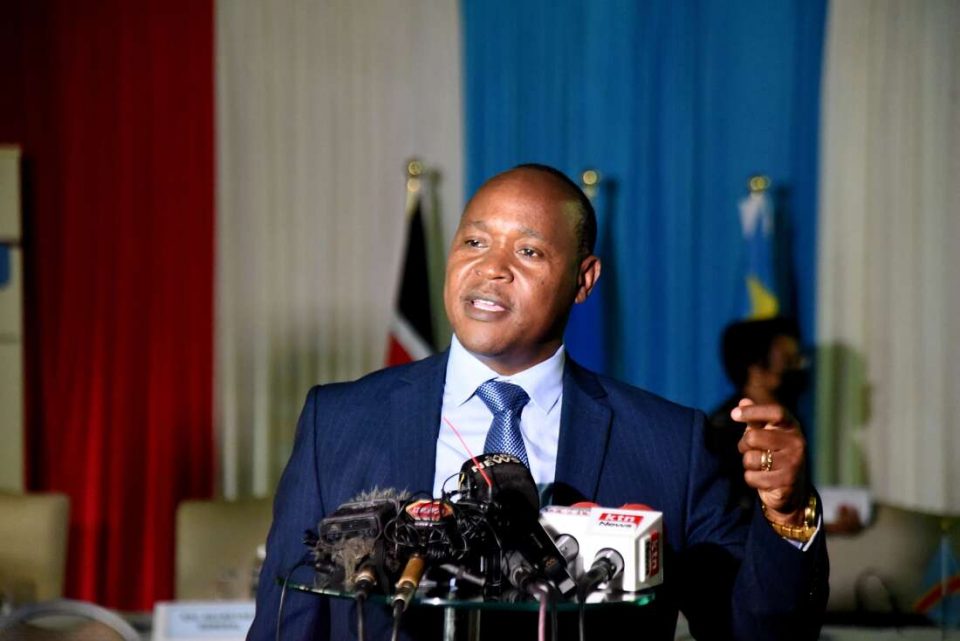Shipping & Logistics
Firms eye cheaper transport costs on DRC entry into EAC
Wednesday March 23 2022
EAC Secretary-General Peter Mutuku Mathuki at a January 17 briefing in Nairobi. PHOTO | DIANA NGILA | NMG
Summary
- The Kenya Association of Manufacturers (KAM), the lobby for factories, has flagged a difficult customs clearance process as a major driver of elevated transportation costs into DRC.
- The EAC’s Customs Union, the bloc’s first integration breakthrough which came to force in 2005, aims at flattening trade barriers, including deterrent logistical costs, at border points for member countries.
- The DRC, the second-largest country by area in Africa after Algeria, is on the verge of joining the regional trading bloc after making a formal application in June 2019.
Kenyan firms are optimistic the imminent admission of the DRC into the six-nation East African Community trading bloc will ease lengthy delays in clearance of trucks entering the populous central African country.
The Kenya Association of Manufacturers (KAM), the lobby for factories, has flagged a difficult customs clearance process as a major driver of elevated transportation costs into DRC.
The EAC’s Customs Union, the bloc’s first integration breakthrough which came to force in 2005, aims at flattening trade barriers, including deterrent logistical costs, at border points for member countries.
This ensures that no country is advantaged in getting access to other markets within the bloc.
“DRC’s tedious and lengthy customs clearance process poses a great challenge to Kenyan firms wishing to venture into the country. Exporters are required to make local arrangements for customs agents, which translates to extra costs,” KAM’s chairperson Mucai Kunyiha said via email.
“As it joins EAC, the DRC should work towards creating a conducive business environment that promotes long-term foreign investment and sustainable economic growth.”
The DRC, the second-largest country by area in Africa after Algeria, is on the verge of joining the regional trading bloc after making a formal application in June 2019.
The EAC Secretary-General Peter Mathuki confirmed Monday the country will be admitted into the bloc on March 29 upon approval by Heads of State Summit, adding a more than 90-million market to the expanding regional trading bloc.
The mineral-rich country is already a key African market for Kenyan firms with latest official annual data showing exports earnings from DRC amounted to Sh14.3 billion in 2020 — only dwarfed by Uganda, Tanzania, Rwanda, Egypt and South Sudan.
Some of the top exports to DRC are animal and vegetable fats and oils, pharmaceutical products, tobacco, iron and steel, leather and footwear, vegetables, fruits, nuts, plastics as well as paper and paperboard.
The lengthy clearance process has, however, become a major risk factor for firms transporting goods into DRC, a market touted as the next frontier for growth on the continent by international development institutions such as the World Bank Group and the African Development Bank.
For example, the US’s International Trade Administration (ITA) — the body which helps American firms compete favourably abroad through supportive trade and investment policies — has described DRC’s customs clearance process as “slow and confusing”.
That barrier has kept transportation costs high, making it expensive to ship goods into DRC and eat into profit margins for firms.
It reportedly takes as many as 10 days to unload a ship at the main seaport of Matadi compared with two days at the Port of Mombasa.
“Significant progress has occurred in the customs sector, including through the development of the one-stop shop (‘Guichet Unique’) in order to reduce fraud, increase the tax base, unify different customs expenses, and improve the DRC’s business climate,” ITA writes in an investment guideline on DRC.
“The programme has been implemented in the capital of Kinshasa, at the port of Matadi, at the Kasumbalesa border crossing on the DRC-Zambian border, in the eastern town of Beni, and is now in other areas, although a lack of funding continues to hinder progress and has slowed down implementation.”
The DRC largely relies on eastern Africa seaports for imports. The port of Mombasa, however, handles less than 15 percent of goods into DRC, with Dar es Salaam in Tanzania and Beira in Mozambique getting the bulk of the deals.
“DRC has three main economic hubs anchored on a strong commercial and industrial base. These include Kinshasa and Kongo Central provinces, Haut-Katanga and Lualaba provinces, and North Kivu, South Kivu, Ituri, Bas-Uele, Haut-Uele as well as Tshopo provinces,” Mr Kunyiha said.
“These hubs offer great market opportunities for investment, especially in the mining sector.”


